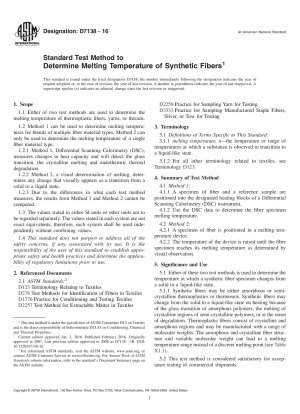ASTM D7138-16
Standard Test Method to Determine Melting Temperature of Synthetic Fibers
- Standard No.
- ASTM D7138-16
- Release Date
- 2016
- Published By
- American Society for Testing and Materials (ASTM)
- Latest
- ASTM D7138-16
- Scope
5.1 Either of these two test methods is used to determine the temperature at which a synthetic fiber specimen changes from a solid to a liquid-like state.
5.1.1 Synthetic fibers may be either amorphous or semi-crystalline thermoplastics or thermosets. Synthetic fibers may change from the solid to a liquid-like state on heating because of the glass transition of amorphous polymers, the melting of crystalline regions of semi-crystalline polymers, or at the onset of degradation. Thermoplastic fibers consist of crystalline and amorphous regions and may be manufactured with a range of molecular weights. The amorphous and crystalline fiber structure and variable molecular weight can lead to a melting temperature range instead of a discreet melting point (see Table X1.1).
5.2 This test method is considered satisfactory for acceptance testing of commercial shipments.
5.2.1 If there are differences of practical significance between reported test results for two or more laboratories, perform comparative testing to determine if there is a statistical bias between them, using competent statistical assistance. As a minimum, use the samples for such a comparative test that are as homogeneous as possible, drawn from the same lot of material as the samples that resulted in disparate results during initial testing and randomly assigned in equal numbers to each laboratory. Compare the test results from the laboratories involved using a statistical test for unpaired data, at a probability level chosen prior to the testing series. If bias is found, either its cause must be found and corrected, or future test results for that material must be adjusted in consideration of the known bias.
5.3 This test method is suitable for quality control testing of synthetic fibers and product comparisons of different fibers by manufacturers, retailers, and users.
5.4 If the test method is used to identify fiber material type, it is important to test a known reference material at the same laboratory with the same test method to confirm the fiber identification. In addition, since some fiber types have similar melting temperatures or overlapping melting temperature ranges as show in Table X1.1, secondary methods for fiber identification as described in Test Methods D276 will be required to make fiber identifications.
1.1 Either of two test methods are used to determine the melting temperature of thermoplastic fibers, yarns, or threads.
1.2 Method 1 can be used to determine melting temperatures for blends of multiple fiber material types. Method 2 can only be used to determine the melting temperature of a single fiber material type.
1.2.1 Method 1, Differential Scanning Calorimetry (DSC), measures changes in heat capacity and will detect the glass transition, the crystalline melting and endothermic thermal degradation.
1.2.2 Method 2, a visual determination of m......
ASTM D7138-16 Referenced Document
- ASTM D123 Standard Terminology Relating to Textiles
- ASTM D1776 Standard Practice for Conditioning and Testing Textiles
- ASTM D2257 Standard Test Method for Extractable Matter in Textiles
- ASTM D2258 Standard Practice for Sampling Yarn for Testing
- ASTM D276 Standard Test Methods for Identification of Fibers in Textiles
- ASTM D3333 Standard Practice for Sampling Manufactured Staple Fibers, Sliver, or Tow for Testing
ASTM D7138-16 history
- 2016 ASTM D7138-16 Standard Test Method to Determine Melting Temperature of Synthetic Fibers
- 2008 ASTM D7138-08 Standard Test Method to Determine Melting Temperature of Synthetic Fibers
- 2007 ASTM D7138-07 Standard Test Method to Determine Melting Temperature of Synthetic Fibers

Copyright ©2024 All Rights Reserved